It was a lovely afternoon, topped off with an invitation to have tea at Mohammed’s mum’s house.
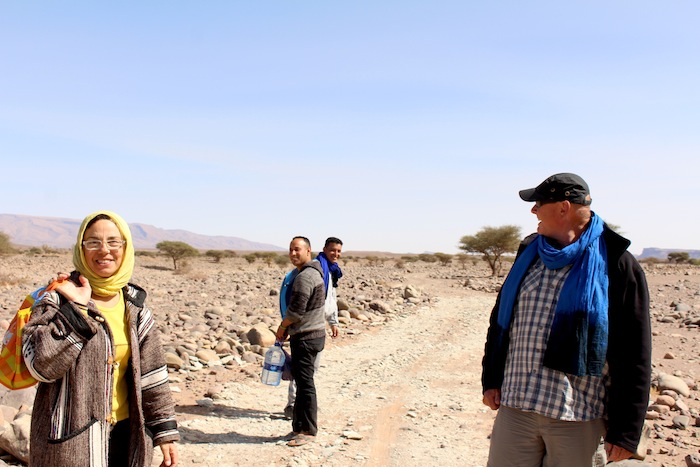
It was a lovely afternoon, topped off with an invitation to have tea at Mohammed’s mum’s house.

Our own camp fire, a night or two under the stars wild camping and then throw in some modern art as well – it was an irresistible combination!
We posted one photo to Facebook a few days ago via our Instagram account, but it was such a lovely location and couple of days, we wanted to share some more of our experience.
Wild camping, or free camping, is not as easy to find in Europe and Morocco as it is in Australia, especially when you have a tent as obvious as Chubby Coleman!
But we found a spot in the valley of Les Roches Peints – the Painted Rocks – near Tafraoute and made camp.
The rocks were painted in 1984 by Belgian artist Jean Veran and apparently a team of Moroccan firemen…. They are dedicated to the woman he loved – she must have been bould(ered) over!
She got painted rocks, we got sunset, stars, the moon and sunrise surrounded by the drama of the naturally red rocks. We think we got the better end of the deal – but check out the rest of the photos below and we will leave you all to be the judges – what do you think?

Our journey south brought us to Agadir and a few days rest in a Berber tent at the Paradis Nomade campsite, a few kilometers north- east of the city.
Everyone seems to like this particular watering hole,
and even the heavens were smiling down on us.
We took time to unload Charlie and then go exploring. Paradise Valley was strongly recommended by our friends Szabina Mozes and Rino Koop so of course we had to go.
Turning inland about 20kms north of Agadir, you take the road up to Imouzzer, through the Anti Atlas mountains, high canyons, river flats and palm trees.
Back down the to coast and more of the increasingly common Moroccan driving experiences
Although we had been warned that driving in Morocco is a hair-raising venture, we haven’t found it to be so … yet!
The roads can be narrow, uneven and potholed in places, the traffic (human and animal) can be challenging and reluctant to give ground, but it is far from the motoring terror that we had been anticipating… watch this space and of course we concede the bit about getting stuck in the sand!
South of the dunes that sucked Charlie into their grasp is the seaside town of Tifnit, and it is about as seaside as you can get.
Walking through the village means walking through a sand dune
Even the boats are landlocked now
Agadir itself is a very modern affair – built almost entirely from scratch after an earthquake destroyed the original city in 1960. The new town has wide boulevards and a retro vibe from its 60s re-birth, but its still the same Morocco underneath.
It is a cosmopolitan place, where Saturday night promenading takes place under the dramatically illuminated hillside declaration “God, Country, King”
Come days end the beach is only good for one thing in Morocco – football is not a national sport it is a national obsession! Even high in the rocky mountains space will be cleared for a pitch!
But the countryside and magnificent long views are never far away
As you can imagine, every turn is a delight or fascination for the eye and the camera. If you want to see more of anything in particular, post a comment and we will be happy to oblige.
Our travels are now taking us inland from Agadir, further south and to the desert, there is plenty more to come!
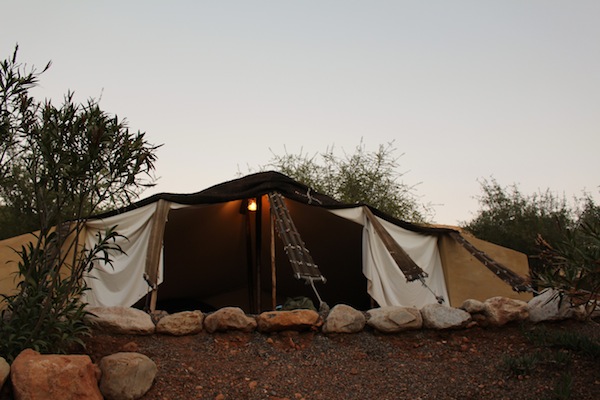
What does it mean to be a nomad? We have lived for months with no home, so it seemed fitting to try a real nomad tent for a few days..
The Berber tent we stayed in, at the Paradis Nomade campsite north east of Agadir, has a low mud wall on three sides, over which is draped the inner and outer skins of the shelter.
The inner skin – a white cotton cover called a haiti – is overlaid with a heavy woven drape, which comes down the the ground on all sides and is thrown back over the top of the frame during the day, to give access to the tent.
The down straps are what the front drape lies across when the “door” is down and also help to give tension to the tent. Often they are decorated with coloured tassels and embroidery.
Of course true nomads don’t settle for long and even though it was a pure indulgence for us to sleep in a bed and not have to raise our own tent each night, it is nothing like the real thing – which we have seen, shielding families from the sun and wind in the most barren of places.
Like the Berbers, we too have already moved on. Check out the story and pictures from our travels in and around Agadir.
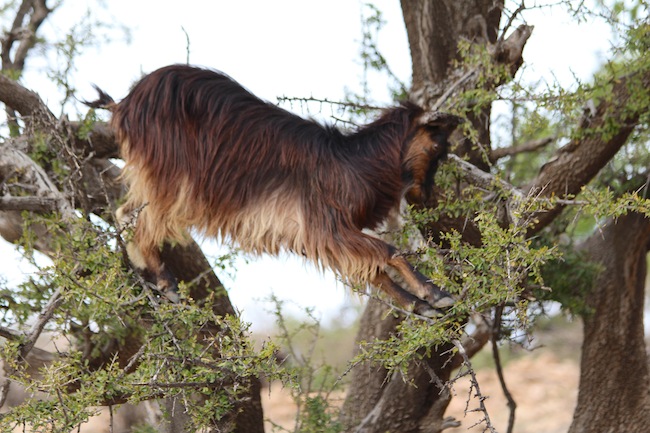
“Goats up trees!”- the shout that brought Charlie Charleston to a rumbling stop on the mountain road, as a shaggy white billy hopped onto a branch in the valley below.
We had been on a mission to find goats up trees since we were told that our hoofed and horned friends were the only creatures allowed by law to climb the fabled Argan trees. Not humans – just kids!
Argan trees are protected in Morocco because of the immense value of the oil that is produced from its nuts. The oil can be used for cooking, medicine and cosmetics for nails, hair and skin – anything really, it is magic stuff.
But it is the collection of the nuts and the relationship with the goats that we found most interesting and entertaining.
Originally the nuts were harvested as a “post-goat” production, if you get our meaning – much like civet coffee. It fell to the women of the villages to sift through the goat droppings to retrieve the partially digested nuts.
Thankfully for the women, times have changed and not only do they no longer use that particular method of softening the fruit, but there is now a high chance that the enterprise selling the oil, soap, powder and other much-prized Argan nut by-products, is a women’s co-operative and not a corporation. Apparently the old Yorkshire saying “where there’s muck, there’s brass” is very true in this case.
Argan trees only grow in a small area of Morocco, in the Anti Atlas region and among the many things we were told about this fabled tree, was that only the nuts that had fallen from the tree can be taken – to maintain the trees protected status and in order to avoid them being over-exploited.
The women collect them from around the base of the tree, pack them up and take them off to be processed. We have passed many patient donkeys shading under the Argan trees, waiting for their panniers to be filled.
Obviously if a herd of goats has just been tap-dancing through the branches, there’s a good chance they won’t have to wait too long.
So, next time you see Argan oil on the shelves – you have the flying goats of Morocco to thank for it!
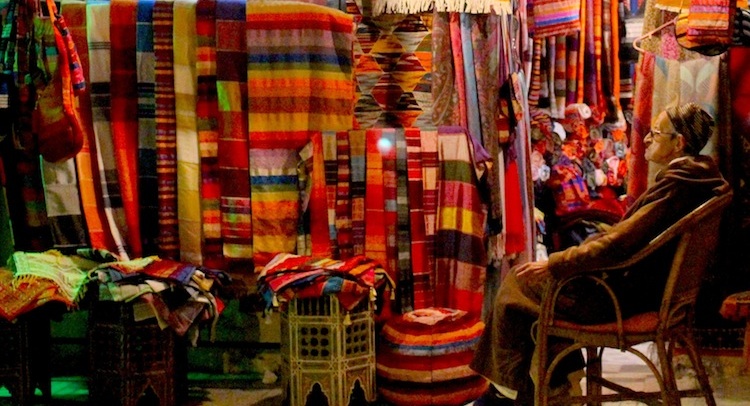
We have never been to Morocco – we had lots of ideas of what it might be like, had read many stories, but we didn’t expect what we got…
We had been looking forward to breaking out the tent again after many weeks in the casita and house sitting and had imagined warm winter sun gently caressing Chubby Coleman, our big old tent left long under wraps.
This was the picture in our heads:
What we got was torrential rain, lightening and thunder. We stayed two nights at our first camp, thinking it would blow over, then packed up between rain clouds and headed south – to the sun, right? Nope. More days of torrential rain, damp tent and to top it all – two punctured airbeds and a dead computer. Nothing exciting or exotic about any of that! Moulay Bousleham is next to a lagoon, which fills with migrating flamingoes in the spring, unfortunately the lagoon seemed more intent on filling the campsite during our flying visit!
Admittedly, the inexplicable giant strawberry outside the mosque did make us laugh, but even the sheep that were herded past our tent for morning and evening feeds – which we also did not expect to see – seemed unimpressed by the relentless rain.
Eventually we managed to catch a break in the rain, packed a soggy Chubby into the car and headed south again.
By the time we got to Rabat, the capital of Morocco, the rain was becoming just a memory and the ancient stones of the Rabat kasbah and necropolis glowed in the sunshine. The blue and white walls and doors of the kasbah are beautiful and worth a visit to the city for that alone.
The ancient necropolis – once a Roman settlement – on the edge of the city is a fascinating place and home to countless clacking storks, but Geoff got a stalk of a different kind – a double dose!
The Hassan Tower in the centre of the city is also a sight to see, set as it is amongst more ancient Roman ruins and guarded by elegant horsemen.
From Rabat, again we have pushed south, toward Casablanca. Is there any other city that so immediately evokes thoughts of Hollywood glamour and excitement? We turned to fellow travellers on the internet for some insider wisdom on the best places to visit. “Do Not Go To Casablanca” was the overwhelming message from almost every review we read. The only thing worth visiting is the Hassan II mosque. Built only a couple of decades ago, in just six years, to honour the dying King, it is one of the largest mosques in the world. Twenty-five thousand devotees can be housed inside and a further 75,000 outside.
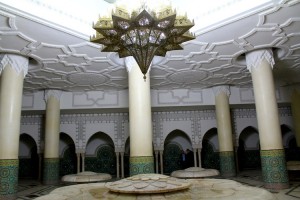
The columns are made partly of eggshells to absorb the damp from the hamman below the Hassan II mosque, Casablanca
It is perhaps true that the only thing worth seeing in Casablanca is the Hassan II mosque, if you are a tourist. Its sheer scale is very impressive, but we have seen more beauty in other buildings. Casablanca itself it simply a very large city – not geared for tourism or visuals feasts. Suckered by Hollywood again!
So onward and further south we have pressed, driving for most of the afternoon past donkey carts, sheep and cattle herders, shepherds, farmers and all points in between.
We landed in Essaouira – a fishing town beloved by surfers in the summer season and a rather chilled and easy place out of season. Those surf-making winds can be rough this time of year though and we had to hang on to Chubby the tent as it was buffeted every which way as we put it up. A tour around town found a wonderful local metal fabricator who, after we had stumbled through our basic French and waved our one remaining tent peg in the air, stopped what he was doing to bend and bang out twelve new heavy-duty pegs on the spot. Chubby is now tight as a drum.
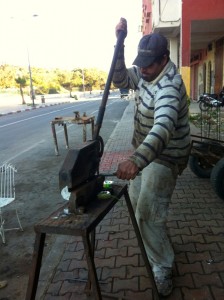
It was no problem for him to stop what he was doing and cut us 12 new tent pegs to battle the Esaouira winds
With Chubby pegged down we were free to explore the sights, smells and colour of the Essaouira medina and port – what a feast for the senses!
We are beginning to settle into Moroccan life – and even Moroccan driving!
We hope to spend some weeks in this new country – exploring the deserts and mountains, coasts and oases – we hope you will come along for the ride.